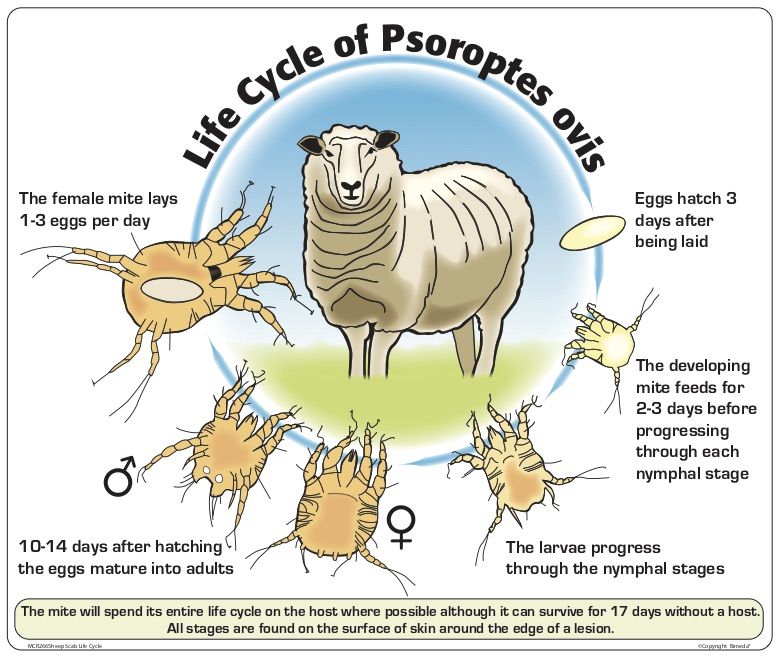
Sheep Scab is a reportable disease but poses no risk to human health.
This guidance is for Wales and England
Under the Sheep Scab Order 1997 it is a criminal offence if owners or keepers of sheep fail to treat sheep visible affected with sheep scab.
Local Authorities can control the movement of sheep that are affected by sheep scab, and require treatment of those sheep if necessary.
If you suspect you have sheep scab in your flock, contact us on 01554 748576 or gwareduscab@colegsirgar.ac.uk
There are two types of treatment available to treat or prevent sheep scab.
They are plunge dipping with the Organophosphate Dip or Macrocyclic lactones – moxidectin doramectin or ivermectin (e.g. Cydectin, Dectomax, Ivomec).
Organophosphate Dip
- This blocks nerve transmission in a molecule common to both the mite, sheep and human users
- Gwaredu Scab recommends full PPE for all users
- Sheep are required to remain in the solution for at least one minute with the concentration maintained.
Macrocyclic Lactones
- These are typically used as wormers and some products are also able to kill scab mites. *Not all products kill mites so it is important to read the datasheets.
- The injection site, dose and withdrawal periods of all products are different and subject to change so it is wise to read the datasheet every time.
Reinfection following treatment
OP dips and SOME macrocyclic lactone will provide prolonged protection after treatment.
If the dip is used correctly then protection lasts 60 days.
For the macrocyclic lactones consult your vet or SCOPS.
There are ways to try and prevent the spread of sheep scab, you should follow biosecurity measures including:
- Quarantining new stock
- Isolating any affected stock
- Double-fencing and maintaining good boundary fences
- Blood-testing to diagnose scab before the appearance of clinical symptoms
- Treatment at times of risk
As sheep scab can be difficult to identify, you should discuss the following with your vet:
- Any concerns
- Treatment plans
- Preventative measures to protect your flock
During the early stages of sheep scab, infestations are not obvious, and animals often appear clinically normal.
It can take 40-50 days after infection before signs are seen.
There are low mite numbers and very small, virtually undetectable lesions.
The first visible signs can be restlessness, rubbing against fence posts, soiled and stained areas of wool, head tossing and loose tags of fleece.
Clinical signs include severe itching and scratching, biting at flanks, restlessness, loss of wool, exudative and pruritic skin lesions, skin covered in scabs and thickened skin, skin excoriation and secondary skin infections, sever pain, weight loss (which can be severe), low birth weights and higher perinatal mortality rates in lambs born to affect ewes.
You should look out for:
- Rubbing and scratching against fence posts
- Nibbling and biting their fleeces
- Dirty areas of fleece from scratching hair, especially behind the shoulder
- Clean areas of fleece, where sheep have nibbled
- Broken areas of fleece on the sides of sheep from biting and scratching
- Affected sheep can be extremely sensitive to being touched. They may respond by nibbling
- Affected sheep may also become dull and depressed and stand apart from the rest of the flock
Sheep Scab is highly contagious and spread occurs through transfer of mites for infected sheep/carrier sheep to sheep free of Psoroptes ovis mites.
It can also occur by transfer of mites present in contaminated wool, equipment, fences, sheds, fields etc rubbing and scratching against fence posts leaving wool infested with mites that can survive up to 17 days off the sheep.
The mite is able to survive in wool tags and skin flakes in the environment for on average 17-days resulting in sheep being able to contract the mite even without coming into contact with sheep. This means that trailers, shearing equipment, marts, fields, etc
Sheep Scab is one of the most contagious parasitic diseases of sheep in Great Britain.
The condition itself is a form of allergic dermatitis cause by highly parasitic scab mite Psoroptes ovis
The female mite lays one or two eggs daily in the fleece of the sheep for about 40 days.
Sheep scab is an intensely pruritic, exudative, allergic reaction to the Psoroptes ovis mites which feeds on oils and proteins found on the skin, causing intense irritation and breakdown of the animal’s skin causing the sheep to itch profusely resulting in patchy wool loss.
Within 6-8weeks, mite abundance will have multiplies massively, the lesion will have spread, sheep will rapidly lose condition and clinical disease will be apparent.

